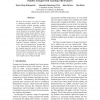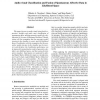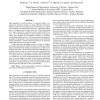JMLR
2010
14 years 7 months ago
2010
Round-based games are an instance of discrete planning problems. Some of the best contemporary game tree search algorithms use random roll-outs as data. Relying on a good policy, ...
113
click to vote
JMLR
2010
14 years 7 months ago
2010
We show how a preselection of hidden variables can be used to efficiently train generative models with binary hidden variables. The approach is based on Expectation Maximization (...
101
click to vote
INTERSPEECH
2010
14 years 7 months ago
2010
This paper reports our recent exploration of the layer-by-layer learning strategy for training a multi-layer generative model of patches of speech spectrograms. The top layer of t...
121
Voted
ICFHR
2010
14 years 7 months ago
2010
We present a complete online handwritten character recognition system for Indian languages that handles the ambiguities in segmentation as well as recognition of the strokes. The ...
104
Voted
ICWSM
2009
14 years 10 months ago
2009
The advent of social tagging systems has enabled a new community-based view of the Web in which objects like images, videos, and Web pages are annotated by thousands of users. Und...
NAACL
2010
14 years 10 months ago
2010
We show how features can easily be added to standard generative models for unsupervised learning, without requiring complex new training methods. In particular, each component mul...
ICPR
2010
IEEE
14 years 10 months ago
2010
IEEE
This paper focuses on audio-visual (using facial expression, shoulder and audio cues) classification of spontaneous affect, utilising generative models for classification (i) in t...
117
click to vote
ICIP
2010
IEEE
14 years 10 months ago
2010
IEEE
Most approaches to learn classifiers for structured objects (e.g., images) use generative models in a classical Bayesian framework. However, state-of-the-art classifiers for vecto...
117
Voted
SSPR
2010
Springer
14 years 10 months ago
2010
Springer
Many approaches to learning classifiers for structured objects (e.g., shapes) use generative models in a Bayesian framework. However, state-of-the-art classifiers for vectorial d...
110
Voted
PAMI
2008
15 years 4 days ago
2008
We investigate whether dimensionality reduction using a latent generative model is beneficial for the task of weakly supervised scene classification. In detail we are given a set ...





